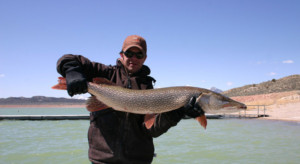
In 2016, I was offered the opportunity to participate in a short course on effective natural resources collaboration hosted by University of Utah’s Environmental Dispute Resolution (EDR) program. So often, professional development courses provide little in the way of tangible benefit. Before agreeing to participate, I wanted to do some research and be sure that this course was worth my investment. I concluded that the EDR short course would not only teach me how I could begin to increase the success of collaborative efforts, it would also afford me the opportunity to undertake a collaborative process in my workplace through completion of an applied capstone project.
My EDR capstone project started almost accidentally. I was sitting in a work planning meeting in 2015, when I heard complaints from Utah Division of Wildlife Resources (UDWR) aquatics section personnel related to the escapement of white sucker and northern pike from a pond. These fish were hurting the native fish in the nearby Green River. Given that this pond was owned by UDWR, one would think that this would be an easy fix. If UDWR owns the pond, surely UDWR can control what fish escape from the pond, right?
I grabbed the folks who were worried about fish escapement immediately after the meeting, with an eye on solving the problem in short order. While talking with these people, I quickly learned the “problem” I was attempting to solve was only a symptom of a much larger issue. You see, the pond—although owned by UDWR—was managed by the wildlife section, and the wildlife section and aquatics section did not collaborate. Somehow, the two sections had become insulated from one another. How did this happen? Weren’t we supposed to be adhering to the principles of ecosystem management, effective communication, partnering, and watershed-scale conservation?
For years, natural resources professionals have been educated in a manner that causes them to focus on discrete segments of larger systems. Additionally, eligibility requirements for funding of natural resources management and conservation activities have become more stringent due to increasing needs, allowing only certain funding to be used for certain activities. I suspect that these two factors, among others, have contributed to the lack of collaboration between professionals identifying with distinct disciplines. Oddly, the resultant “siloing” we are seeing here at UDWR, and elsewhere, comes at a time when the need for collaboration to solve complex problems has never been greater for natural resource professionals.
So, when I agreed to take part in the Environmental Dispute Resolution program’s short course on effective natural resources collaboration in 2016, I came with a clear objective in my head: Learn enough in this course to elicit a change in the way UDWR professionals worked together across disciplinary boundaries. In my capstone project, I went back to the specific issue of fish escapement I mentioned earlier. My thought was to use collaboration to move a specific project to successful completion in an effort to showcase the value of collaboration to a broader UDWR audience. And so I began assembling the diverse array of aquatics, wildlife, and habitat interests within UDWR and conducting my situation assessment interviews.
Interview results provided me with a list of three things the group needed to address in order to begin deconstructing silos and truly collaborating: (1) establish trust; (2) repair relationships; and (3) rekindle the need for interdependency and interconnectivity among natural resources professional disciplines. Completion of these three objectives is a tall order and an ongoing process. In December 2016, the assembled group had recognized the need for increased trust and interdependency and was on their way to repairing relationships through completion of the fish escapement project that addressed a variety of interests, including waterfowl management, equitably. Phase I of this project is slated to take place this year, and the group has discovered that collaboration increases the likelihood that stalled projects will get off the ground.
I, too, have personally discovered quite a lot along the way. One lesson I learned during my capstone project is that it is critical to assemble a diverse array of collaborators to ensure that problems are examined from every angle and that synergy is triggered. However, the most important lesson I have learned through my capstone project is that without regular interactions, collaborative team members can find it easy to revert back to their comfort zones, sequestering themselves behind the walls of their well-built silos. As a result, I have begun to schedule more frequent group interactions during various collaborative efforts to increase the likelihood of long-term behavioral change among collaborative team members.
As I continue to hone my collaborative skills during ongoing efforts related to this capstone project and other collaborative efforts, I am astonished at how powerful collaboration can be. Whether addressing a personnel management issue, a project that has languished, or a plan that needs to be developed, the tools that I acquired during the EDR short course continue to serve me well.
 Craig Walker specializes in sport fish management, angler access, and fish habitat restoration at the Utah Division of Wildlife Resources. He completed the EDR program’s short course on effective natural resources collaboration in 2016.
Craig Walker specializes in sport fish management, angler access, and fish habitat restoration at the Utah Division of Wildlife Resources. He completed the EDR program’s short course on effective natural resources collaboration in 2016.
